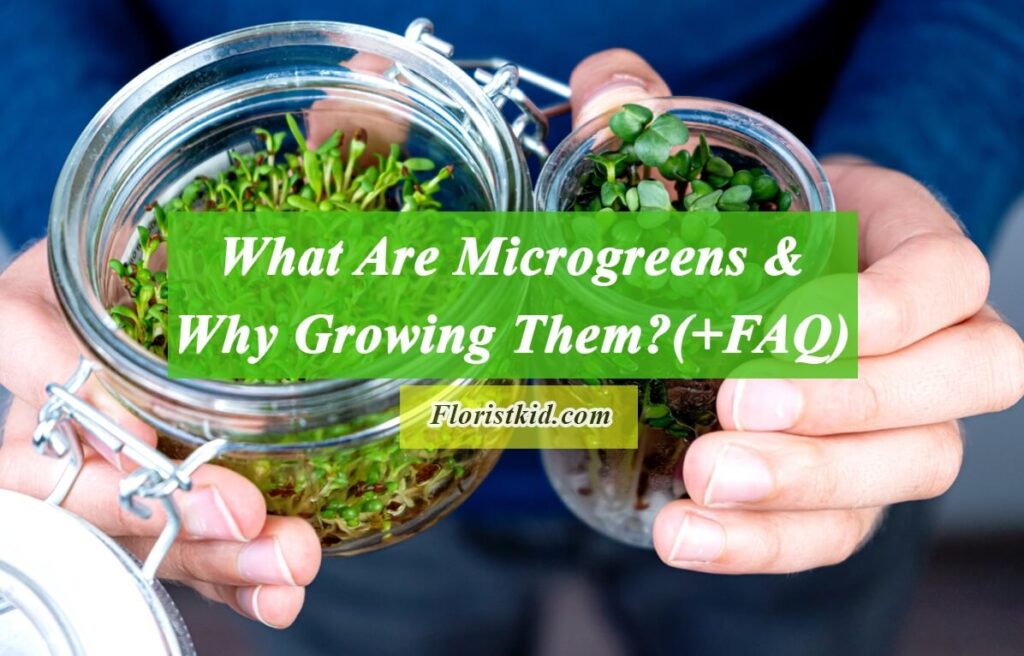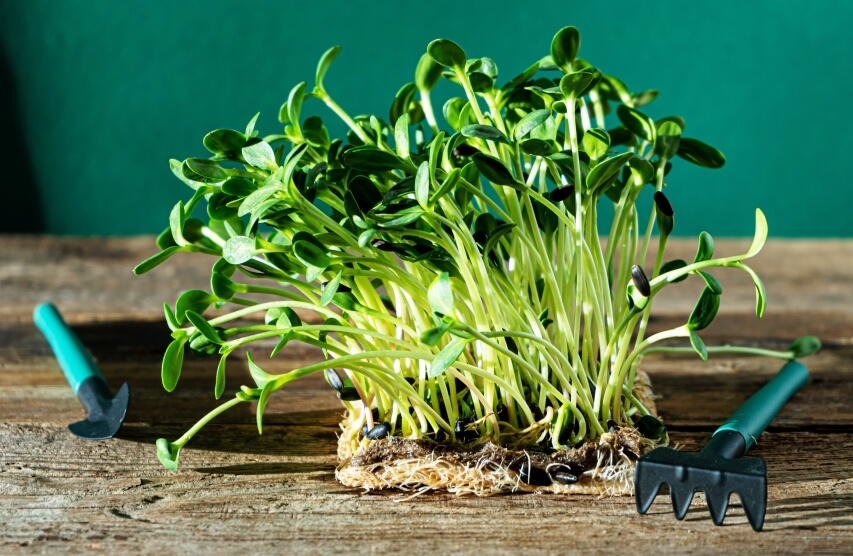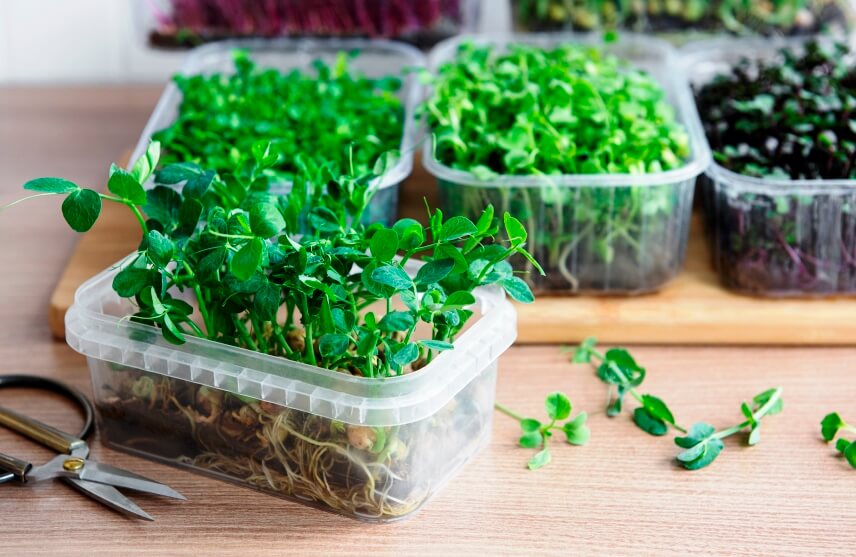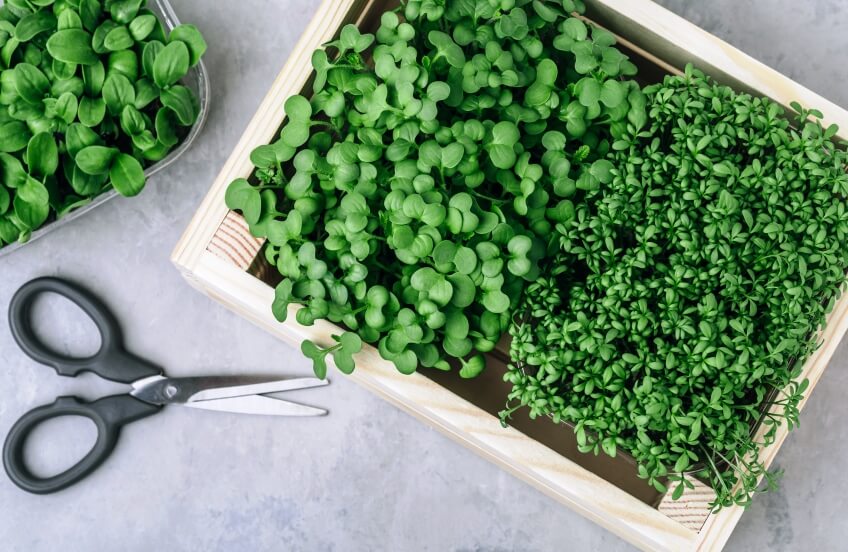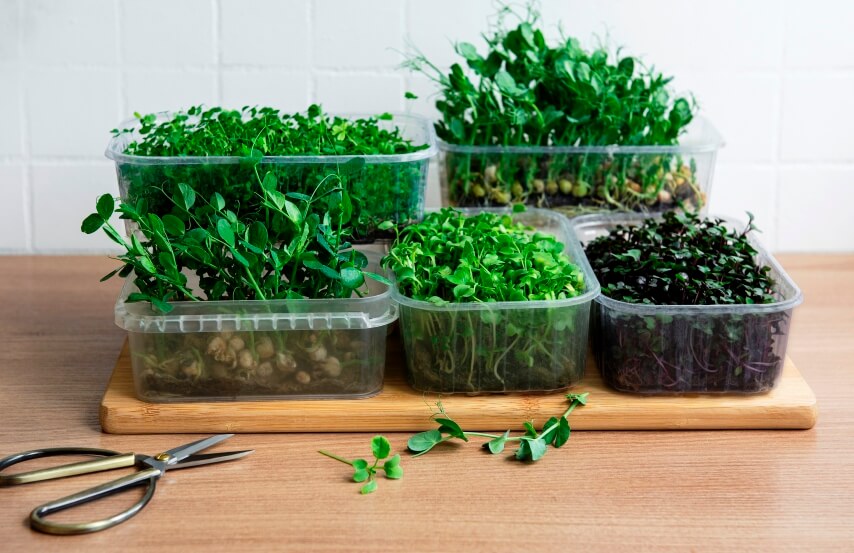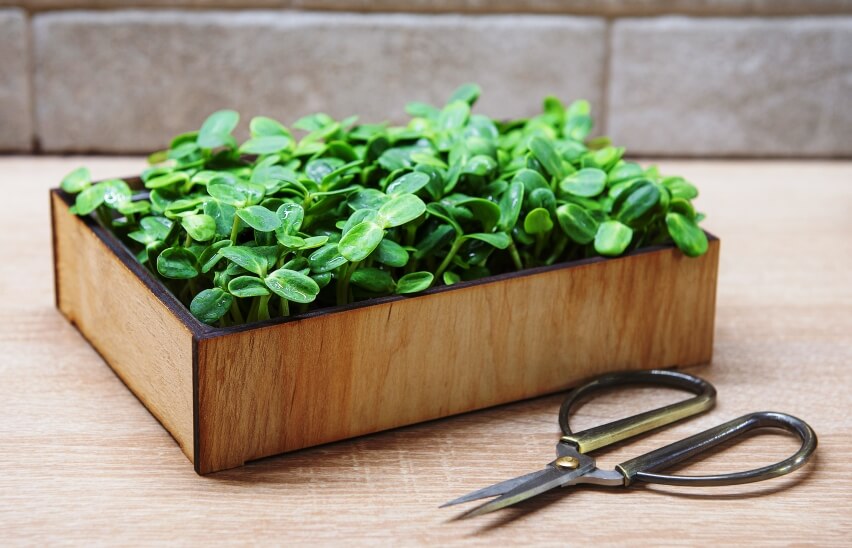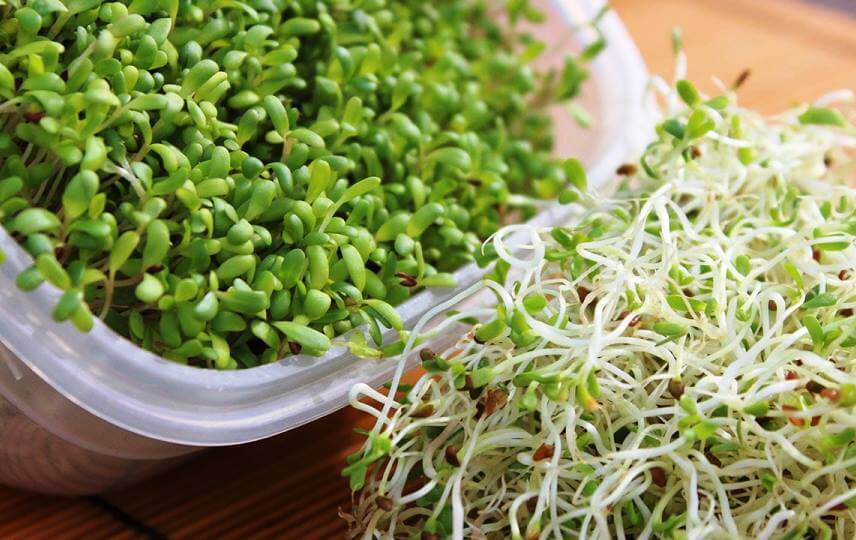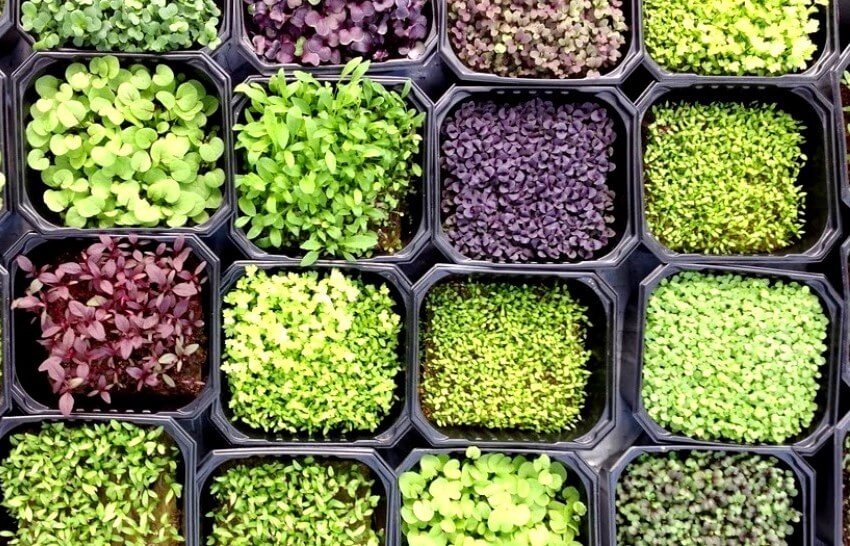Microgreens have become a trendy new culinary trend over the past few years. From New York to Shanghai, chefs have been using them to artistically enhance food plates and give their dishes new dimensions of flavor.
Microgreens are picked very early and are delicate, nutrient-rich, and highly delicious. They feature a variety of flavors that range from sweet to salty to earthy to spicy, as well as a crisp yet melt-in-your-mouth texture. Today, microgreens have a unique place in the expanding culinary interest due to these unique qualities.
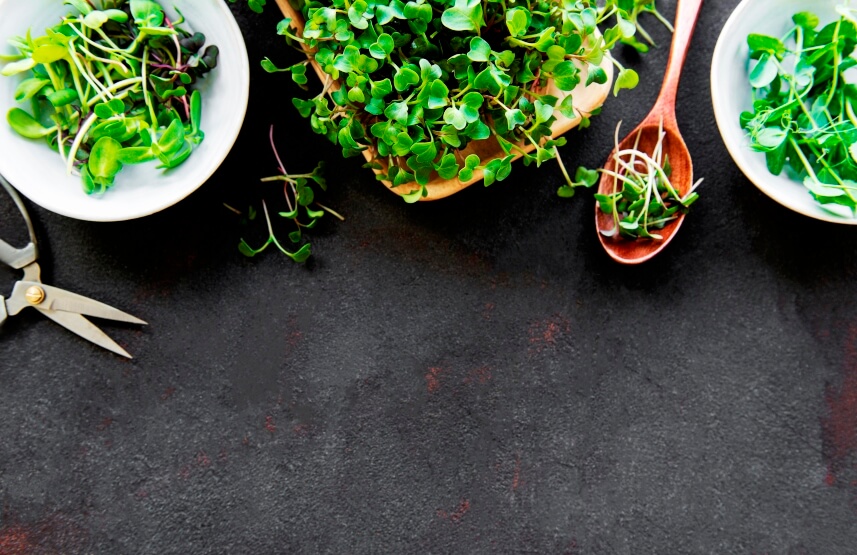
What are microgreens?
Microgreens, micro herbs, micro plants or micro leaves are young seedlings of edible herbs and vegetables. They are harvested before they have the chance to develop into fully-grown plants. They are usually harvested one to three weeks after they emerge from their seed.
Google trend for the term ‘microgreens’
Let’s compare microgreens with sprouts to give you a better idea of what they are like.
Clover sprouts
Sprouts are grown in a moist setting, such as a sprouting jar. All sprout parts, including roots, stems, and leaves, are consumed. Sprouts are harvested within 2 or 3 days, and no growth medium or soil is utilized for growing them.
Microgreens
Microgreens are grown in soil or another growing medium. Only the microgreen’s stem and leaves are edible. They are harvested in one to three weeks after germination. They are also grown from a much wider variety of plants than sprouts.
Although microgreens can be consumed independently, they are usually added to food as a decorative element. This is due to how intense the flavor can be. Microgreens are frequently used in smoothies, drinks, salads, and soups.
Microgreens can be used in various ways, benefiting almost everyone. You can make microgreen juice, add them to salads, or combine them to create a smoothie.
Why microgreens?
To begin with, growing microgreens is just enjoyable. They may be cultivated indoors, allowing you to witness your seeds develop into healthy micro plants.
They do not take up much space in your home as they are little. Additionally, growing them is fairly simple. This is so that you do not have to worry about being able to maintain the plant alive for a very long time since microgreens are harvested so quickly.
Since microgreens are nutritious superfoods, they are the perfect option for growing indoors. You can add them to a salad or a smoothie. This is a straightforward approach for increasing the amount of vitamins, antioxidants, and nutrients in your diet daily.
Microgreens can also make money for us, which is another motivation to cultivate them. As a result of their rapid growth and a favorable return on investment, they have a quick turnaround. Consumers who care about their health are willing to spend more for the already-grown micro plants.
Different Types of Microgreens
There are various types of seeds that can be used to grow microgreens. The following plant families’ seeds are usually used to create the most popular varieties [1]:
- Brassicaceae family: Cauliflower, broccoli, mustard, turnip, cabbage, garden cress, radish, kale and arugula.
- Asteraceae family: Lettuce, endive, chicory and radicchio.
- Apiaceae family: Dill, carrot, fennel, parsley, cilantro and celery.
- Amaryllidaceae family: Garlic, onion, leek.
- Amaranthaceae family: Amaranth, quinoa, swiss chard, beet and spinach.
- Cucurbitaceae family: Melon, cucumber and squash.
Sometimes, legumes like chickpeas, beans, and lentils, as well as grains like rice, oats, wheat, corn, and barley, are also grown as microgreens.
Depending on the species, microgreens’ flavors can range from neutral to peppery, mildly acidic, or even bitter. Their flavor is typically thought to be intense and concentrated.
Microgreens nutritional value
Microgreens, despite their tiny size, actually have a more potent flavor than larger veggies and herbs. According to studies, they can even be up to 40 times more potent in phytochemicals and offer additional health advantages.
A study published in the Journal of Agricultural and Food Chemistry examined 25 different types of microgreens, and it found that, on average, micro plants contain four to six times more nutrients than their mature counterparts. For instance, cilantro microgreen had three times as much beta-carotene as its mature counterpart, whereas red cabbage microgreen had 40 times more vitamin E and six times more vitamin C than mature red cabbage.
Among the microgreens examined, garnet amaranth microgreen had the highest concentration of phylloquinone (a type of vitamin K), cilantro had the highest concentration of carotenoids (an antioxidant found in foods with bright colors), green daikon radish microgreen had the highest concentrations of tocopherols (a type of vitamin E), and red cabbage had the highest concentration of vitamin C.
Despite having a high nutritious content, micro plants are not often considered a viable alternative to conventional vegetables because of the expense and amount required to consume them.
Health Benefits of Microgreens
Vegetable consumption is associated with a reduced risk of numerous diseases. This is because they contain such high levels of vitamins, minerals, and other plant chemicals.
Compared to mature greens, micro plants have higher concentrations of essential nutrients. As a result, the health benefits of microgreens are similar to vegetables. They may also lower the risk of the following diseases:
- Heart disease: A type of antioxidant known as polyphenols, abundant in microgreens, has been associated with a lower risk of heart disease. According to studies, microgreens may lower “bad” LDL cholesterol and triglyceride levels.
- Alzheimer’s disease: Foods like micro plants with high amounts of antioxidants, notably those with high polyphenol content, may reduce the risk of Alzheimer’s disease.
- Diabetes: The type of stress that can prevent sugar from properly entering cells may be lessened with the aid of antioxidants. Fenugreek microgreens appeared to improve cellular sugar absorption by 25–44% in laboratory experiments.
- Certain cancers: Fruits and vegetables high in antioxidants, mainly those high in polyphenols, may reduce the chance of developing several types of cancer. Microgreens with high amounts of polyphenols would be expected to have similar results.
Frequently asked questions about microgreens (FAQ) [2]
What are microgreens, petite edibles and baby greens?
In the realm of gardening, microgreens are still a relatively new phenomenon, so it makes sense that the terminology is unclear. Generally speaking, microgreens are the edible shoots and leaves of salad greens, leafy vegetables, herbs, and some flowers. They are planted closely together in soil and collected while still relatively young, frequently two or three weeks after seeding.
The greens are divided into three size categories by several expert growers. When the plants reach a height of 1½ to 2 inches, we harvest the “microgreens”. At 2 to 3 inches, “Petite Edibles” are harvested, and Baby greens are picked when they are 3 to 4 inches tall.
All three size groups are sown, cared for, and harvested similarly, with small variations in growing techniques depending on the variety. In salads and other recipe applications, any of the three size categories may be employed. Nowadays, many people refer to all of these three greens by the general term “microgreens,” even though distinct labels are frequently used to differentiate among them based on harvest size.
What is the difference between shoots and sprouts?
Several types of microgreens go by the term “shoots.” Green tendrils and tips of pea plants are referred to as “pea shoots.” Squash and sunflower seeds produce soft, wholesome progeny called squash and sunflower shoots. Hard red spring wheat produces wheatgrass shoots, which are commonly blended to create a protein-rich smoothie. Popcorn has somewhat smaller seeds than regular corn kernels, and both corn and popcorn shoots grow from those seeds.
Sprouts are grown without the need for a growing medium, in contrast to microgreen shoots, which are all grown in soil. They grow from the seeds of greens or grains in water and low light and are consumed as immature seedlings with all of their roots, most frequently in salads and on sandwiches.
Note: It is crucial to follow the directions included with the sprout seeds for soaking, rinsing, and storing the product since food safety is a more significant concern with sprouts than microgreens.
Are heating pads useful for growing microgreens?
Heating pads, also known as propagation heat mats, can undoubtedly accelerate the germination of microgreen seeds, which is beneficial for plants known for their tendency to germinate slowly, such as celery, lemongrass, and parsley.
They may be plugged into an electrical outlet, positioned under your growth trays, and come in sizes that are simple to handle. Most high-quality heat mats have thermostats that enable temperature adjustment and are waterproof. Constant heat that is provided directly to the root zone may be beneficial for the seeds that need a soil temperature of 70 degrees Fahrenheit to sprout.
Although heating mats have advantages, they also have drawbacks that may outweigh their benefits. Watering becomes considerably more challenging when they make plants dry out from the bottom up.
Generally speaking, small-scale home gardeners do not need to spend money on pricey heating equipment. Microgreens can be grown uniformly and with better germination rates without using heat mats or additional electricity.
Are grow lights necessary for growing microgreens?
If there is not much natural light where you reside, grow lights should be taken into consideration. Grow lights make it possible to grow plants in places that are not often conducive to gardening, such as attics, basements, and even closets. Grow-light systems are now more affordable because of energy-efficient lighting. The initial cost of grow lamps can be in the hundreds of dollars. However, there is plenty of information online about DIY installations that reduce initial costs.
Instead of extending the length of exposure to light in a continuous sequence, grow lamp users frequently make the mistake of turning them on in the middle of the night for a few hours. It is better to arrange your lights on a timer to turn on from 3 to 7 am and then again from 5 to 9 pm, you will be doing your plants more favors and effectively extending their growing day from 10 to 18 hours.
Should we use domes for growing microgreens indoors?
Domes replicate greenhouse conditions for your plants, keeping your sowing trays warmer and potentially increasing germination rates. However, employing them carries a few dangers. Strong sunlight may occasionally pour through the plastic dome.
Domes also encourage moisture to accumulate inside the planted area. Keep in mind that microgreens are planted much closer together than most outdoor garden crops, so healthy plants require good air circulation. Domes completely stop the airflow.
Why is cheesecloth a better cover material for seeds than paper or cloth towels?
After repeated waterings, the sheer weight of the even sturdy paper towels may hinder seedling growth. Additionally, if you are not careful, paper towels will absorb moisture from the seedbed. For tender micro plants, linen or other cloth towels are too heavy, and washing them after use might be a hassle.
Commercial growers can purchase horticultural cheesecloth, but it comes in enormous rolls much larger than a single home gardener would need. You may cut household cheesecloth to fit the size of your sowing or growing containers. Double-layering the material will give it more durability.
Is it necessary to fertilize microgreen plantings?
Most of your microgreen crops will not need much in the way of nutrition. It is better to use an organic soil mixture for your basic planting medium that contains some nutritional supplements to promote plant growth.
Some microgreens, such as chive, lemongrass, and sorrel, can survive for three cuts or more. Following the initial harvest, fertilizer will be beneficial for these crops. To encourage regrowth, use liquid seaweed, fish emulsion, or other mild organic plant food.
Why is it so important to keep everything “organic”?
The fact that the little shoots and seedlings are so concentrated in flavor and taste shows that there is a cause-and-effect connection between the plants and the organic soil mix they are grown in. The resulting microgreens would be indubitably less tasty and nutrient-dense if you use a chemical-based soil mix instead of an organic soil mix.
Compare lettuces cultivated organically to those found in supermarkets, which are always so large and gorgeous in their gleaming bin displays. Organic lettuces have more bite and flavor, even though they may not be as attractive as supermarket lettuces.
What are the pros and cons of pre-soaking?
Large microgreen seeds like sunflower, wheatgrass, pea and corn seeds all benefit from soaking in room-temperature water before planting. These seeds will not only germinate faster after soaking up the liquid, but they will also germinate so more evenly. Due to the uniform growth of all shoots to the desired height, the crop will yield more when harvested. Remember that these seeds must be well drained in a colander before sowing.
Pre-soaking smaller seed presents a challenge since it frequently causes the seed to clump, making it difficult and time-consuming to sow the seed evenly across the seedbed.
How much crops are required to supply a couple or a family of four with microgreens all year?
If we estimate a total yield of one-third to a half pound of microgreens per 10” x 20” microgreen growing tray, keeping six to eight trays in production (at various stages of growth) should be more than enough to supply the need of your family for fresh greens.
Only two or three trays may be sufficient for a single person who lives alone or has a small gardening area.
Do we need a pH meter for testing our water and our soil?
The cost of pH meters can range from less than $10 to more than $100 in garden centers or via garden catalogs. It is worth mentioning that expensive meters will likely yield the most precise readings.
It is unnecessary to conduct any testing if you use a commercial organic soil mix as your planting medium. These kinds of soil mixes have already been evaluated and altered to match the ideal pH for plant growth. But it could be a good idea to test the soil first if you want to use garden soil to grow microgreens.
The ideal soil for growing herbs and vegetables, including microgreens, has a pH of 6.2 to 6.5. Plants are most productive in that range, soaking up all the nutrients required to promote development.
Below that range, the pH is too sour or acidic; above, it is too sweet or alkaline. These conditions prevent plants from growing. While peat moss or wood chips increase the soil’s acidity, lime or potash makes the soil sweeter.
Should we rinse microgreens after harvesting?
Although microgreens are grown in soil, proper irrigation techniques, such as spraying plants with a soft spray or watering plants from the bottom up, may maintain your crops so clean that rinsing is unnecessary. Additionally, it will keep microgreens dry and dirt-free if you stop watering 8–12 hours before harvest.
If you want to rinse microgreens, do so before using them in recipes and dry them off with paper towels afterward. If you want to preserve an excess of freshly collected micro plants in the fridge for several days, place them in plastic bags without washing them. Remove them as needed to rinse and dry them right before use.
How do the seasons affect microgreen growth rates?
Most microgreens are cold-weather plants that can be cultivated in any environment, but the significantly reduced natural light in northern regions from around December 1 to March 1 will reduce the growth rates. Microgreens will take one to two weeks longer to reach the harvest stage in a winter environment since the sun has a shorter daily duration and is lower on the horizon, where it produces less heat.
Without the use of heat pads and grow lamps, the few heat-loving microgreens, including amaranth and basil microgreens, take so long to germinate and flourish. Many gardeners decide to postpone planting these crops until the spring.
Can cucumber seeds be grown as a microgreen?
Neither cucumbers nor squash makes good microgreen crops. The cucumber seed produces branches, but they essentially have no shelf life. They quickly lose the ideal flavor and texture, albeit temporarily acquiring a nutty flavor.
The herb salad burnet is the perfect microgreen to grow if you desire a distinct cucumber flavor. It readily germinates, grows, and yields leaves that have a distinctive cucumber flavor.
How accurate are the health benefits claimed for making microgreens a regular part of the diet?
Microgreens are a relatively new addition to the culinary world, and little scientific research has been done on their nutritional content or their positive impact on human health. However, numerous credible studies have already shown that immature vegetable and herb plants like microgreens contain many times more nutrients than their fully developed counterparts.
How can we prepare used seedling trays for reuse in growing micro plants?
Use a garden hose to rinse each seedling tray thoroughly, and then scrub them with a diluted solution of one part household bleach to nine parts water. After one more rinse, they are prepared for planting.
How can we avoid overwatering microgreens?
Both seeds and seedlings might suffer from an excess of moisture. Slow-growing plants are particularly susceptible to fungus and mold. “Damping off” is a phenomenon that happens when fungus in the soil attack seeds and seedlings as they are developing. In such conditions, sprouts are destroyed as soon as they reach the surface or after germination, and seedlings wilt and die when they reach an inch in height.
For healthy microgreens, airflow is almost as essential as light and warmth. Microgreens may remain damp for too long after being watered during the winter when the windows are tightly sealed in the house. You may prevent water-damping issues by placing a tiny, portable fan among your plants and using it to blow air through them gently.
You can also keep your microgreens healthy and fungus-free by using proper watering techniques. Only irrigate once the soil seems dry to the touch. Always water (and fertilize, if necessary) in the morning at the base of plants rather than on top of them.

